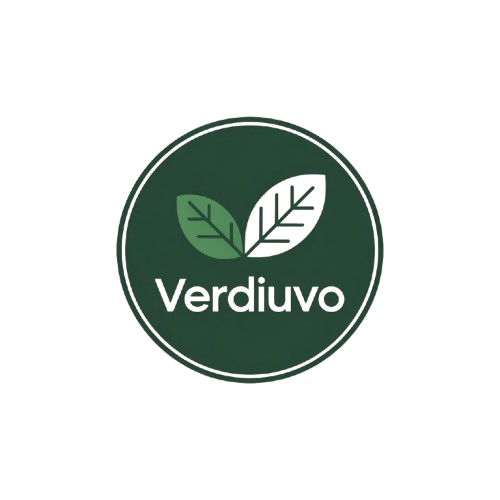Tired of deciphering labels packed with unpronounceable chemicals? Yearning for skincare that’s pure, effective, and tailored to your skin’s needs? Welcome to the empowering world of Non-Toxic Moisturizer Recipes. This movement isn’t just a trend; it’s a conscious choice to nourish your skin with nature’s potent botanicals, free from synthetic preservatives, parabens, sulfates, and phthalates. For the fashion-forward woman who views radiant skin as her ultimate accessory, DIY moisturizers offer unparalleled control, purity, and luxury. Dive into these 7 meticulously crafted Non-Toxic Moisturizer Recipes and unlock the secret to a healthier, more luminous complexion.
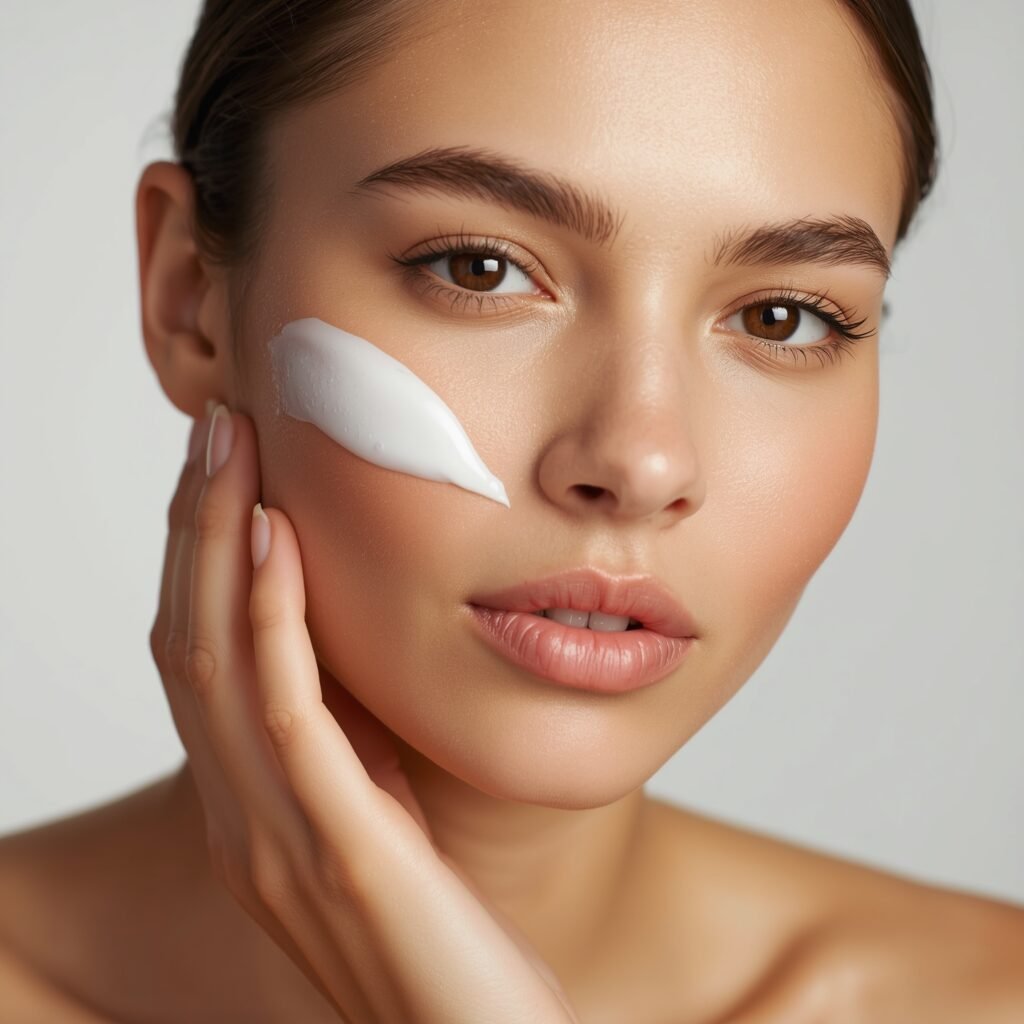
Why Non-Toxic Moisturizer Recipes Are Your Skin’s Best Friend
Commercial moisturizers often hide a cocktail of irritants and endocrine disruptors. By embracing Non-Toxic Moisturizer Recipes, you reclaim power over what touches your largest organ. Benefits are undeniable:
- Ingredient Transparency: Know every component that goes into your glow.
- Customization: Adapt textures and actives for dryness, oiliness, aging, or sensitivity.
- Cost-Effectiveness: Luxurious results without the luxury mark-up.
- Eco-Consciousness: Reduce plastic waste and chemical runoff.
- Potent Efficacy: Unprocessed, cold-pressed oils and butters deliver concentrated vitamins, antioxidants, and fatty acids.
Your Non-Toxic Moisturizer Recipes Pantry: Essential Ingredients
Building your DIY arsenal is simple. Stock these clean, multitasking heroes:
- Base Oils: Jojoba (mimics skin’s sebum), Sweet Almond (lightweight), Coconut (rich, antibacterial – use fractionated for lighter texture), Rosehip Seed (regenerative, high in Vitamin A), Argan (nourishing).
- Butters: Shea (ultra-moisturizing, anti-inflammatory), Cocoa (rich barrier repair), Mango (softer, easily absorbed).
- Hydrosols/Teas: Rosewater (toning), Chamomile tea (soothing), Green tea (antioxidant-rich) – use as a replacement for water in recipes.
- Natural Emulsifiers & Thickeners: Beeswax (creates balms), Vegetable Glycerine (humectant), Cornstarch/Arrowroot (light mattifying).
- Active Boosters: Aloe Vera Gel (soothing hydration), Raw Honey (antibacterial, humectant), Vitamin E Oil (preservative, antioxidant), Essential Oils (lavender for calm, tea tree for blemishes – always dilute properly).
7 Radiant Non-Toxic Moisturizer Recipes
1. Soothing Aloe Vera & Green Tea Gel Moisturizer (For Oily/Combination Skin)
Why You’ll Love It:
This feather-light gel quenches thirsty skin without clogging pores. Aloe calms inflammation, while green tea fights free radicals and shines. A perfect Non-Toxic Moisturizer Recipe under makeup.
Ingredients:
- 1/4 cup pure Aloe Vera Gel (fresh or high-quality store-bought)
- 2 tbsp strongly brewed Green Tea (cooled)
- 1 tbsp Vegetable Glycerin
- 1 tsp Jojoba Oil
- 5 drops Tea Tree Essential Oil (optional, for acne-prone skin)
- 1/4 tsp Vitamin E Oil (natural preservative)
Instructions:
-
- In a clean bowl, whisk together aloe vera gel and cooled green tea until smooth.
- Gently whisk in vegetable Glycerin and jojoba oil.
- Add tea tree oil (if using) and vitamin E oil. Whisk thoroughly.
- Transfer to a sterilized air-tight pump bottle or jar.
Storage & Shelf Life:
Keep refrigerated. Use within 1-2 weeks.
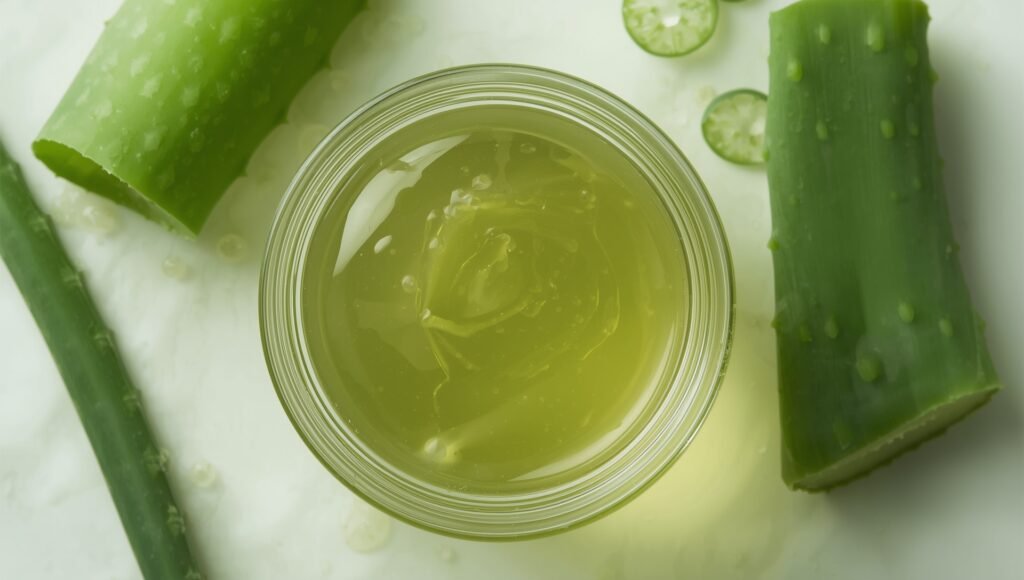
2. Luxurious Rosehip & Jojoba Anti-Aging Cream (For All Skin Types, Especially Mature/Dull Skin)
Why You’ll Love It:
Rosehip oil’s stellar reputation for fading scars and wrinkles is combined with jojoba’s balancing properties in this rich yet fast-absorbing cream. A star Non-Toxic Moisturizer Recipe for luminosity.
Ingredients:
- 1/4 cup Rosehip Seed Oil
- 2 tbsp Jojoba Oil
- 1.5 tbsp Beeswax Pellets
- 2 tbsp Distilled Rosewater or Chamomile Tea (cooled)
- 1 tsp Vitamin E Oil
- 8 drops Lavender Essential Oil (or Frankincense for extra anti-aging)
Instructions:
- Create a double boiler: Simmer 2 inches of water in a saucepan, place a heatproof bowl on top (ensure it doesn’t touch the water).
- Add beeswax pellets, rosehip oil, and jojoba oil to the bowl. Heat gently until the beeswax is fully melted.
- Remove from heat. Slowly drizzle in the rosewater/chamomile tea while whisking vigorously and continuously until the mixture emulsifies and thickens slightly.
- Let cool for 5-10 minutes. Whisk in vitamin E oil and essential oil.
- Pour into sterilized jars while the mixture is still slightly warm but thickening. Seal.
Storage & Shelf Life:
Store in a cool, dark place. Use within 3 months.

3. Ultra-Nourishing Coconut & Shea Butter Balm (For Very Dry/Sensitive Skin)
Why You’ll Love It:
Intensely reparative, this balm creates a protective barrier for parched or irritated skin. Shea butter’s healing power combines with coconut’s deep moisture in this essential Non-Toxic Moisturizer Recipe for winter or flare-ups.
Ingredients:
- 1/4 cup Unrefined Shea Butter
- 3 tbsp Coconut Oil (solid)
- 2 tbsp Sweet Almond Oil
- 1 tbsp Beeswax Pellets
- 1 tsp Vitamin E Oil
- 10 drops Chamomile Essential Oil (optional, supremely calming)
Instructions:
- Using a double boiler (see recipe #2), melt the shea butter, coconut oil, and beeswax pellets together until they are fully liquid.
- Remove from heat. Stir in sweet almond oil.
- Allow the mixture to cool slightly (but not solidify). Stir in vitamin E oil and chamomile essential oil (if using).
- Pour into small sterilized tins or jars. Let set completely at room temperature until solid.
Storage & Shelf Life:
Store at room temperature. Use within 6 months.

4. Refreshing Cucumber & Mint Gel-Cream (For Normal/Combination Skin)
Why You’ll Love It:
Instantly cooling and hydrating, this gel-cream feels like a spa treatment. Cucumber soothes puffiness, while mint offers a refreshing tingle. An ideal Non-Toxic Moisturizer Recipe for warm weather or morning revivals.
Ingredients:
- 1/3 cup fresh Cucumber (peeled, deseeded, blended & strained for juice)
- 2 tbsp Aloe Vera Gel
- 1.5 tbsp Light Oil (like Grapeseed or Fractionated Coconut Oil)
- 1 tbsp Vegetable Glycerine
- 1/2 tsp Cornstarch or Arrowroot Powder (for light mattifying)
- 5-8 drops Peppermint Essential Oil
- 1/4 tsp Vitamin E Oil
Instructions:
- Blend peeled, deseeded cucumber until pureed. Strain through a fine mesh sieve or cheesecloth to extract juice. Discard pulp.
- In a bowl, whisk together cucumber juice, aloe vera gel, and vegetable glycerin.
- Slowly drizzle in the light oil while whisking continuously to emulsify.
- Sprinkle in cornstarch/arrowroot and whisk vigorously until smooth and no lumps remain.
- Stir in peppermint essential oil and vitamin E oil.
- Transfer to a sterilized bottle or jar.
Storage & Shelf Life:
Refrigerate. Use within 1 week.
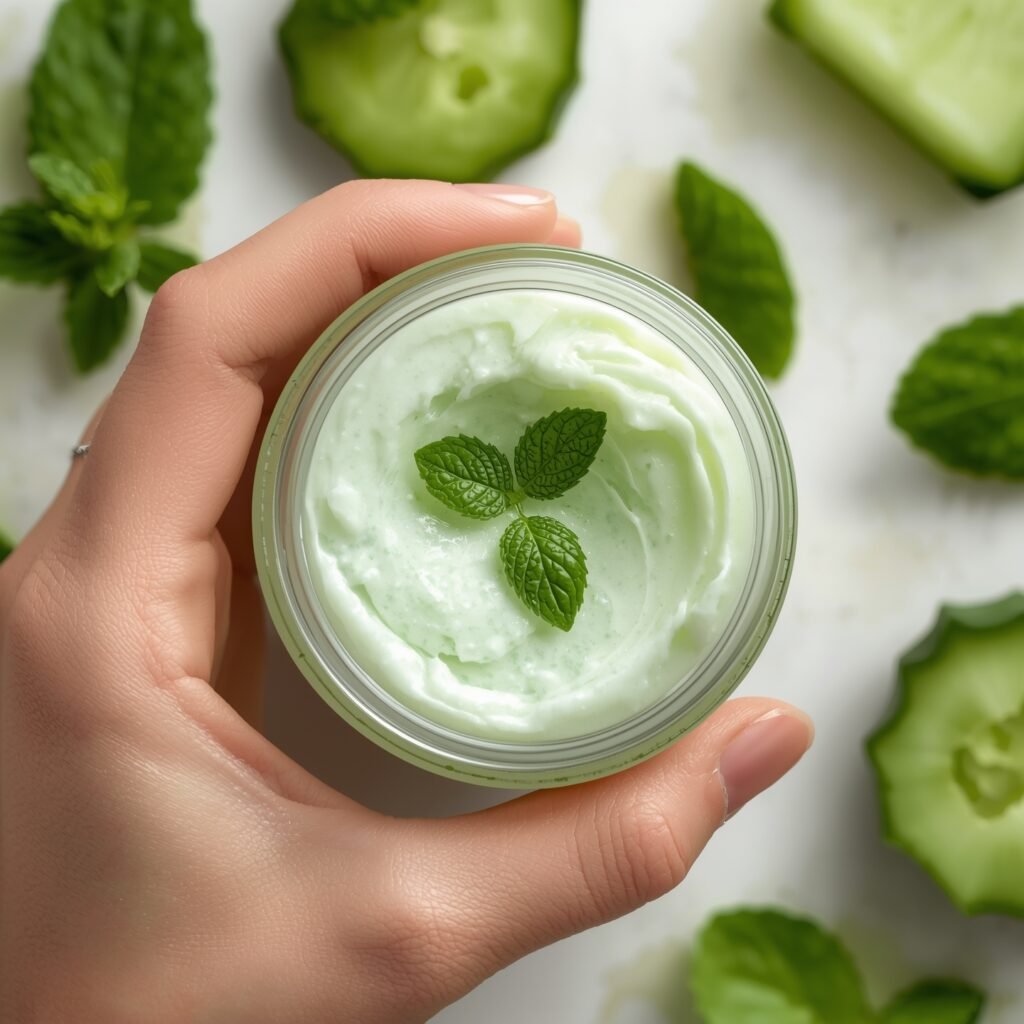
5. Repairing Avocado & Honey Night Cream (For Dry/Damaged/Dehydrated Skin)
Why You’ll Love It:
Avocado oil delivers omega fatty acids and vitamins deep into the skin, while raw honey heals and gently exfoliates. This rich, reparative Non-Toxic Moisturizer Recipe is perfect for overnight rejuvenation.
Ingredients:
- 3 tbsp Avocado Oil
- 1 tbsp Beeswax Pellets
- 1 tbsp Coconut Oil (solid)
- 1 tbsp Raw Honey (manuka is excellent if available)
- 1 tbsp Shea Butter
- 1 tsp Vitamin E Oil
- 5 drops Carrot Seed Essential Oil (optional, for regeneration)
Instructions:
- Using a double boiler, melt beeswax, coconut oil, and shea butter.
- Remove from heat. Stir in avocado oil.
- Allow the mixture to cool for about 10 minutes (it should be warm but not hot enough to destroy honey’s enzymes). Whisk in the raw honey vigorously until fully incorporated.
- Whisk in vitamin E oil and essential oil (if using).
- Pour into sterilized jars. The mixture will thicken as it cools completely.
Storage & Shelf Life:
Store in a cool, dark place. Use within 2 months.
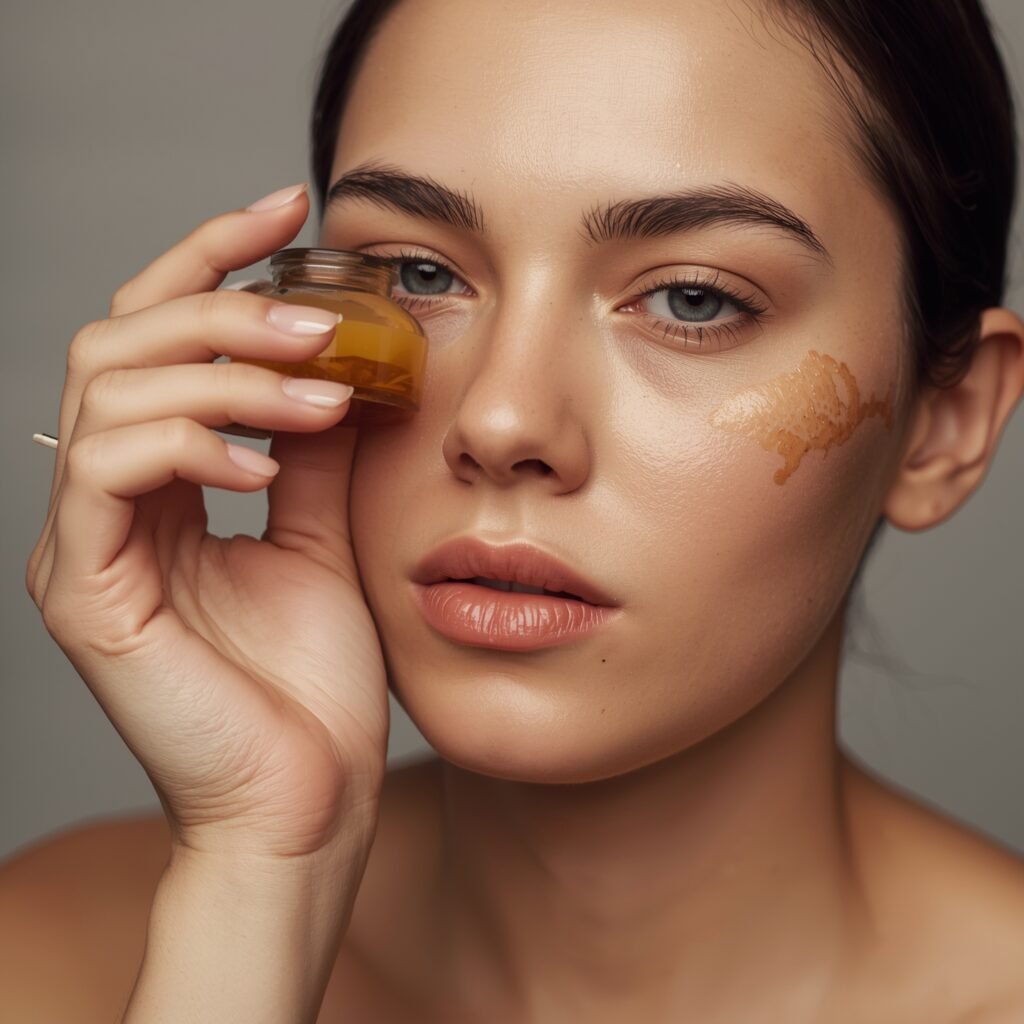
6. Calming Oatmeal & Chamomile Lotion (For Sensitive/Reactive/Rosacea-Prone Skin)
Why You’ll Love It:
Colloidal oatmeal is a dermatologist-recommended superstar for soothing irritation and eczema. Combined with chamomile, this gentle Non-Toxic Moisturizer Recipe calms redness and strengthens the skin barrier.
Ingredients:
- 1/4 cup Chamomile Tea (strongly brewed & cooled)
- 2 tbsp Colloidal Oatmeal (or finely ground rolled oats in a coffee grinder)
- 2 tbsp Sweet Almond Oil or Sunflower Oil
- 1 tbsp Beeswax Pellets
- 1 tbsp Aloe Vera Gel
- 1 tsp Vitamin E Oil
- 3 drops Roman Chamomile Essential Oil (optional, extra soothing)
Instructions:
- Melt beeswax with sweet almond/sunflower oil using a double boiler.
- Remove from heat. Slowly drizzle in the cooled chamomile tea while whisking constantly until emulsified and creamy.
- Let cool for 5 minutes. Whisk in aloe vera gel and vitamin E oil.
- Gradually sprinkle in the colloidal oatmeal, whisking continuously to prevent clumps.
- Stir in Roman chamomile essential oil (if using).
- Pour into sterilized jars.
Storage & Shelf Life:
Refrigerate for best stability. Use within 3 weeks.

7. Brightening Vitamin C & Sea Buckthorn Serum-Moisturizer (For Dullness/Hyperpigmentation)
Why You’ll Love It:
Harness the power of stable Vitamin C (from Sea Buckthorn Oil) and antioxidants to fade dark spots and boost radiance. This lightweight, potent Non-Toxic Moisturizer Recipe doubles as a treatment serum.
Ingredients:
- 3 tbsp Rosehip Seed Oil
- 1 tbsp Sea Buckthorn Oil (Note: Highly pigmented – start with less!)
- 1 tbsp Argan Oil
- 1 tsp Vitamin E Oil (boosts stability and efficacy)
- 5 drops Lavender Essential Oil (optional, for soothing)
- (Optional: Add 1/4 tsp cosmetic-grade Vitamin C Powder (SAP or Ester-C) dissolved in 1 tsp distilled water for extra boost – add at the end)*
Instructions:
- In a small sterilized glass dropper bottle, combine rosehip seed oil, argan oil, and vitamin E oil.
- Crucial: Add sea buckthorn oil DROP BY DROP (it’s very orange and potent – 1 tbsp may be too much for some; start with 1 tsp and adjust). Shake bottle gently.
- Add lavender essential oil (if using) and shake again.
- (Optional Step): If using additional Vitamin C powder, dissolve it completely in 1 tsp distilled water. Once fully dissolved, add this mixture to the oils in the dropper bottle. Shake very vigorously until emulsified (it will be slightly cloudy).
Storage & Shelf Life:
Store in a dark glass bottle in a cool, dark place (refrigeration extends life). Use within 3 months (6 weeks if water-based Vitamin C is added).
Patch Test:
Sea Buckthorn can stain temporarily. Apply at night.
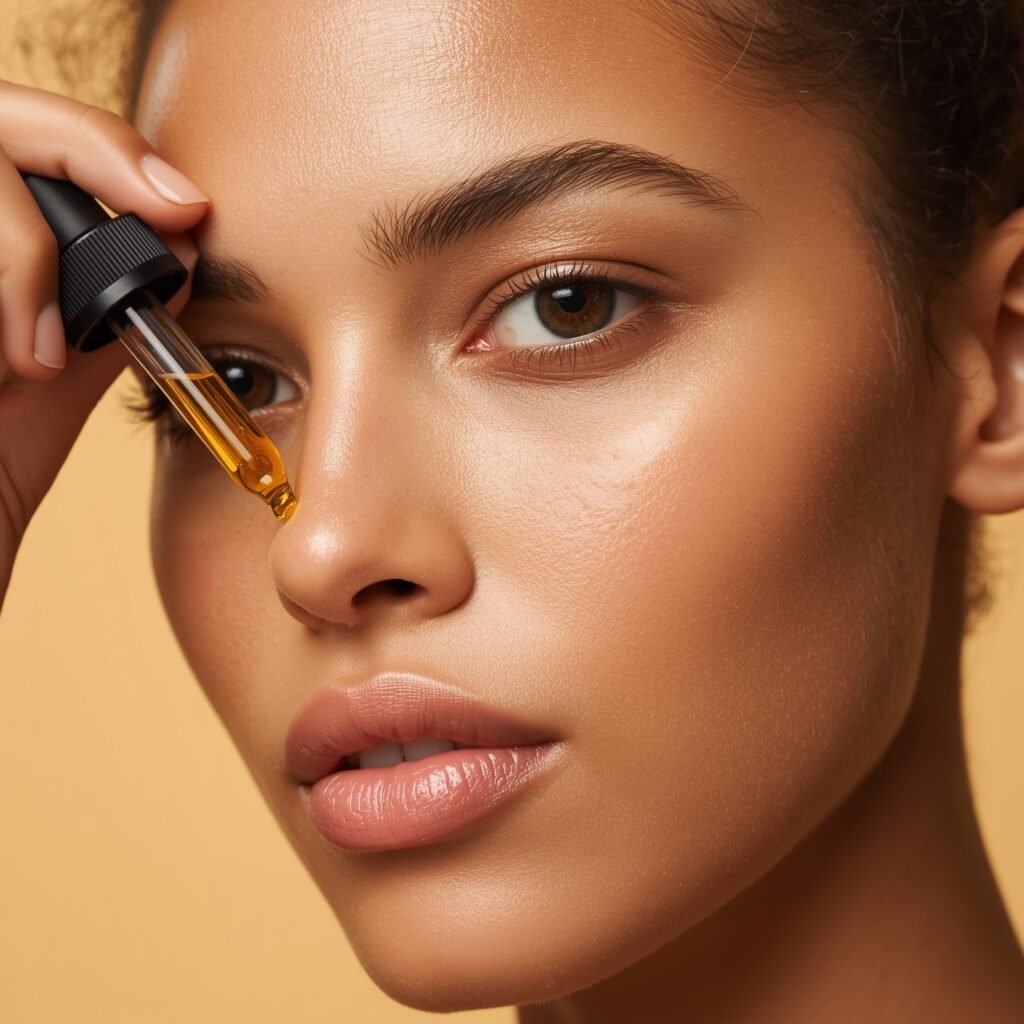
5 Pro Tips for Mastering Your Non-Toxic Moisturizer Recipes
- Sanitation is Sacred: Always sterilize jars, bottles, bowls, and utensils (boil for 10 mins or wipe with high-proof alcohol) to prevent bacterial growth and extend shelf life.
- Patch Test Power: Before slathering on a new creation, apply a small amount to your inner forearm. Wait 24 hours to check for any reaction, especially with essential oils or new ingredients.
- The Water Rule: Recipes with water (teas, hydrosols, aloe juice) are highly perishable. Always refrigerate them and use within 1-3 weeks. Anhydrous recipes (oils/butters/wax only) last much longer (3-6 months+).
- Preserve Naturally: Vitamin E oil is a good antioxidant, but it doesn’t kill microbes. For water-containing recipes, consider natural preservatives like Leucidal Liquid or Radish Root Ferment (use according to instructions). Refrigeration is essential.
- Emulsify Like a Pro: When combining oil and water phases (like in creams), both should be at similar temperatures (warm). Whisk the water phase INTO the oil phase slowly and continuously for a stable emulsion. A small hand blender can help.
Conclusion: Craft Your Confidence with Non-Toxic Moisturizer Recipes
Embarking on your DIY skincare journey with these Non-Toxic Moisturizer Recipes is more than a beauty choice; it’s an act of self-care and empowerment. You’ve learned that pure, effective hydration doesn’t require complex chemistry, just nature’s wisdom and your own hands. From the soothing embrace of oatmeal to the radiant boost of sea buckthorn, you now possess the formulas to address your skin’s unique needs, free from hidden toxins.
Start simple. Choose one recipe that sings to your skin’s current craving. Gather your ingredients meticulously, embrace the process with patience, and relish the satisfaction of applying something you crafted with intention. Notice the difference pure botanicals make – the vibrant glow, the calmer complexion, the empowered feeling. Share your creations, tweak the recipes, and truly make them your own. Your most radiant, healthy skin awaits, handcrafted by you. Dive in, create, and glow confidently!
Top Asked Questions (FAQs):
What are the best natural ingredients for a DIY moisturizer?
Answer Highlighted in Article: Base oils (jojoba, almond, rosehip), butters (shea, cocoa), aloe vera, honey, beeswax, hydrosols, vitamin E oil, and essential oils (properly diluted) are key players. See the “Essential Pantry” section.
How long do homemade non-toxic moisturizers last?
Answer Highlighted in Article: Shelf life varies drastically! Water-based recipes (gels, lotions) last 1-3 weeks refrigerated. Oil/butter-based balms last 3-6+ months. Vitamin E helps. See individual recipes and Pro Tip #3.
Are DIY moisturizers safe for sensitive skin?
Answer Highlighted in Article: Yes! DIY allows you to control ingredients, avoiding common irritants. Focus on simple recipes like the Oatmeal & Chamomile Lotion. Always patch test! See Recipe #6 and Pro Tip #2.
Can I make a non-greasy natural moisturizer for oily skin?
Answer Highlighted in Article: Absolutely. Use light oils (jojoba, grapeseed), aloe vera, green tea, and gels like the Aloe & Green Tea or Cucumber & Mint recipes. See Recipes #1 and #4.
What is a natural preservative for DIY skincare?
Answer Highlighted in Article: Refrigeration is primary. Vitamin E is an antioxidant but not a broad-spectrum preservative. For water-based products, consider natural options like Leucidal or Radish Root Ferment. See Pro Tip #4.
How do I thicken my DIY moisturizer naturally?
Answer Highlighted in Article: Beeswax (for balms/creams), cornstarch/arrowroot powder (light gels/lotions), or emulsifying wax (for stable creams) are natural thickeners. See ingredients in various recipes.
Can DIY moisturizers help with anti-aging?
Answer Highlighted in Article: Yes! Oils like rosehip and sea buckthorn (Recipe #7) are packed with vitamins and antioxidants that combat free radicals and support collagen. See Recipe #2 and #7.
